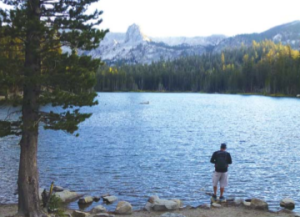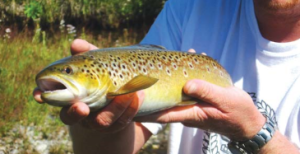MAMMOTH TROUT AWAIT
TWIN LAKES, MAMIE AND GEORGE AMONG TOP-NOTCH FALL FISHING OPPORTUNITIES
By Mike Stevens
Fall in the Eastern Sierra is characterized by light crowds, mild temperatures and incredible trout fishing that will make the “summer-only” veteran wonder why he or she doesn’t come up after Labor Day every year.
Late-season trout take on an entirely different attitude no matter where on the east side you are chasing them, and the Mammoth Lakes Basin is no exception, as the following breakdown illustrates.
TWIN LAKES
The two things that are evident within minutes of your first visit to Twin Lakes is that there are actually three interlocked lakes with a lot of weeds out there. While the weeds can cause headaches for those fishing from shore who didn’t score one of the few primo spots, they create an ideal environment for trout by giving them a place to hide, as well as support the ultimate source of protein in the form of aquatic insects. Both of those factors make Twin a popular spot for float tubers, fly anglers or a combination of both.
From a float tube, you can kick through the channels along the weedlines and work the open-water areas. Those fishing with spinning gear can attack Twin Lakes with green or brown Rooster Tails, trout jigs in any natural color – the Sierra Slammers jig in the grasshopper color is to die for here – and it’s a great spot for fly-and-bubble fishing with dries like California mosquitoes and callibaitis, or streamers like Doc’s Twin Lakes Special or
olive Matukas.
The upper lake below the waterfall is a great area for larger-model rainbows or big browns that patrol this highly oxygenated, protein-rich spot. The middle lake doesn’t get a lot of angling pressure, but it produces better-than-you-would-think numbers of brook trout along the rock slide. The lower lake stands as the best one for shore fishing, with the best spots being along the road, where open water is within casting range.
Here’s a quick tip for Twin Lakes: The sun dips behind the peaks earlier than at other Mammoth Basin lakes, and that can put the bite into “evening mode” as early as 4 p.m. If you plan on fishing your way around the lakes in late afternoon, start here.

LAKE MARY The largest of the basin’s lakes, Mary has a ton of fishable shoreline and is big enough to comfortably accommodate everything from kayaks to pontoon boats with plenty of room to spare. Naturally, this is a great lake to troll in, and top-line trolling with pink Berkley Flicker Shads or Tasmanian Devils is a great way to locate and hook Lake Mary stockers looking to get fat before the big freeze.
The coves by both boat ramps and stump areas near inlets are historically productive spots for producing big fish, and while Mary isn’t known as a “brown bagging” lake, it will kick out above-average numbers of brown trout around the inlets toward the last couple months of the season.
Bait dunkers can expect easy limits on PowerBait or Mice Tails on longer leaders, or using a water-filled bubble instead of a sinker to stay above the weeds. Lure chuckers do well on all the Sierra standards like Thomas Buoyants, Kastmasters and trout jigs with a trout-worm trailer.
As far as divulging secrets for catching fish at Lake Mary, here is one that I discovered about five years ago and have been taking advantage of ever since. Show up here and fish from 7 to 8 p.m. (This also works in the summer, but you fish until 9 p.m.)
Every night – like clockwork – a major insect hatch takes place, and what seems like every trout in the lake rushes the shore to feed on them. You’ll see dimples and splashes in both directions within 20 feet of the shore, so even rookie bug-slingers can plop a dry fly (size 18 to 20 Parachute black gnats or elk hair caddis) on top of them. And while this feeding frenzy always seems to turn them off of chasing lures, PowerBait fished just beyond where they are visibly feeding can often produce a quick limit.

LAKE MAMIE
Mamie is similar to Twin Lakes in that it is shallow and has a fair amount of weedy areas. But it is much more accommodating to shore fishermen, so much so that the best spots are among the easiest to get to.
It’s all about finding the deeper holes and channels that dot and carve through the smallest lake in the basin, and most of these spots are conveniently located directly in front of the parking lot near the outlet or within a 15-minute walk up either shore.
Unless you get there early, the shore right by the lot will be occupied, but you can typically sneak off to the left side and access the brush-lined cove near the resort’s boat dock. It’s a great spot to throw Buoyants on a slow retrieve for rainbows cruising the shoreline early and late in the day. Larger trout like to hang out near the bridge on the other side of the parking lot for a few days after they have been stocked. A local secret for catching these trophies is tossing nightcrawlers with no weight and letting them drift in the current as it funnels toward the outlet before dumping off the cliff into Twin Lakes.
Like Twin Lakes, Mamie is a great option for float tubers using a long rod. Positioning your tube well offshore and directly in front of the parking lot and stripping olive or brown Woolly Buggers on an intermediate or sinking line will produce both numbers and lunkers at Mamie.
Sometimes, trailing smaller nymphs like Hare’s Ears, Pheasant Tails and Prince Nymphs behind them can make all the difference when plying these waters for fall trout.
“Use sinking lines and brightly colored red, orange and fluorescent green streamers to draw strikes from bigger fish,” says Doug Rodricks of Sierra Drifters Guide Service (760-935-4250; sierradrifters.com). “That really applies to all the lakes in the basin throughout the season.”
Bait aficionados can fish PowerBait, Berkley Mice Tails or Pinched Crawlers on a shorter leader in these locations, and if you want to get into the fly bite at Mamie on spinning gear, you can fish the aforementioned streamers on a fly-and-bubble rig (fill bubble all the way with wet flies) and do just as well as the tubers, once you find them.

LAKE GEORGE While smaller in surface acreage than other lakes here, George makes up for it in depth. A good portion of the shoreline requires a little rock-hopping to make your way around, but there are plenty of bank-fishing spots to accommodate the fishing pressure ol’ “Jorge” receives all summer. Indeed, this upper basin lake was this past season’s most consistent trout producer.
The best way to attack George is to start off on the shoreline to the right of the boat dock and use spoons like Buoyants, Kastmasters or Hot Shots to experiment with depth and cover as much of the cavernous water column that you can. Hit all the spots as you move up the shoreline toward the first inlet and spend a bit more time in this area, as it is one of the most productive areas for larger trout on the lake.
Something you also might be lucky enough to notice at Lake George is how groups of trout like to school up and move up and down the shoreline, which makes them the perfect target for trout jigs or trout worms rigged on a size 8 Owner Mosquito hook and a BB splitshot. Finding an elevated section of bank will help you spot them; if they breeze through and disappear, wait about 20 minutes or so before you chase after them because they will likely swing by again.
Trolling is so-so at George, but trophies have been caught by guys going deep with leadcore line and Needlefish. If you want to fish bait along the steeper shorelines, it’s best to use a water-filled bubble rather than a lead sinker because the neutrally buoyant set-up will slowly make its way through that deep water and find biters eventually. CS



